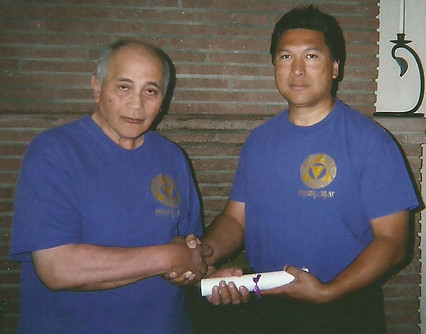Pentjak Silat Pak Sera(h,k) MDT


For the record, the islands of Indonesia, Java in particular have not been submerged in the last 20 million years. This has allowed for the development of one of the oldest known societies on the planet that has an unbroken line of succession. Some of the oldest known fossil records of early man exist on Java. The indigenous peoples became very attuned to the natural world around them and over many centuries, this led to the development of a mystical consciousness and way of living that fostered a respect and close interaction with the elemental powers of nature itself. From this beginning the art of Pentjak Silat was born. It is not really an “art”, as the Indonesian language has no word for art. It is actually more of a form of living life. Art is not separated from life.
Pentjak Silat is the romanized form of the concept for “stylized lightning motion”. At its roots are the preservation of the self through the harmonious movements of redirection and deflection of movement, force and energy. A true master of Pentjak Silat practices the ability to ward-off attack through the redirection of energy in and around his /her immediate environment. This takes a few years to develop and requires the help of a master. An apprentice is usually brought into the fold and taught as a member of the family. In this manner the information and training is passed on from generation to generation. Entire Pentjak Silat societies were formed and from these societies a culture was developed. It is accepted that the West Javanese Pentjak Silat style reached a level unsurpassed in the islands and became the model for other styles to mold themselves after.
In more recent times a gifted practitioner of West Javanese Pentjak Silat created a method of training enabling his students to rapidly advance in the theory and movements of Pentjak Silat. Because of his raspy voice his students nicknamed him “Pak Sera(h,k)”. Pak (respectful title for an elder ) Sera (meaning… one with a raspy voice). Pak Sera.
Pak Sera became widely recognized as a “wise person”, a gifted teacher and healer. He took on two apprentices and educated each one in the finer points of “Pentjak Silat Pak Sera(h,k)” until they acquired mastery. One was named Abang Djut. Abang Djut taught two apprentices, brothers named John and Ernest de Vries who also reached a level of mastery that satisfied the requirements of the style. These two, in turn, taught “Pentjak Silat Pak Sera(h,k)” to their nephew Maurice de Thouars until he too fulfilled the requirements.
In February of 1999 Maurice de Thouars gave recognition to one of his students and conferred upon him the designation of full apprentice. Then in May of 2004 Maurice de Thouars gave Dr. Andre KnustGraichen the title of “heir and successor” in Pentjak Silat Pak Sera(h,k).As well as excepting his younger Brother Guru Hans, and a handful of his students into his direct lineage.
This system you now will learn the complet Offensive and Defensive system. With all the Langhaks and Pantjar platforms. The 18 long form Djurus. The Trisula Djurus. And all the application associated with them. Gurus in our system may be able to have access to the video libray of Archived film footage of all out Bapak of the system .
Bapaks Maurice, Dolf, and Dr Andre. You can see them perform the complete system.

Uncle Maurice de Thouars,December 28,1928 -May 20,2014 Born in Pare (Indonesia) is the oldest of the Thouars brothers. In Indonesia he lived with his family on the Tegowangi sugar plantation.
As an adolescent, he first studied with his uncle Ventje and later with his uncle John, both experienced teachers Gave him full Guru ranking and lineage.
In service with NATO, Maurice fought 2x in the Korean War. A real hero and recognized by the government with various awards.
His philosophy: "Serak is meant as respect to the deepest form, and not to the ego.
Serak is in your head and is not on 'a piece of paper'.
If you understand this, then you begin to understand Serak ' .



